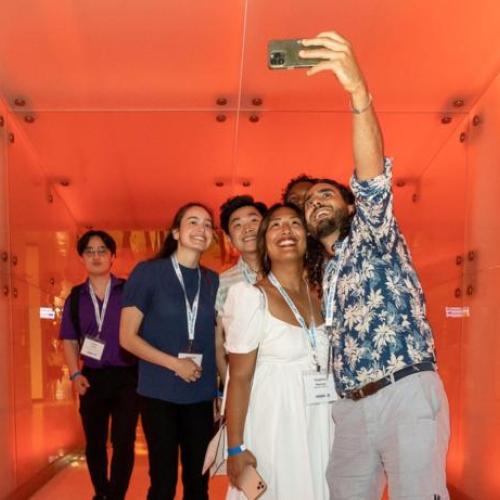June 11, 2021 | Volunteer & Awards
U of T deep learning pioneer Geoffrey Hinton receives honorary degree
By Scott Anderson

When you translate a sentence using Google, or ask Siri to send a text, or play a song recommended by Spotify, you are using a technology that owes much to the innovative research of Geoffrey Hinton (Hon DSc 2021).
The technology is “deep learning” – a form of artificial intelligence (AI) based on neural networks. Over the past 20 years, deep learning has moved from the fringes of computer science into applications that are now transforming almost everything humans do, from diagnosing disease to driving a car. Hinton’s revolutionary contributions to the field have earned him the nickname “the godfather of deep learning,” and have made Canada a hotbed for high tech.
Today, for his excellence as a global pioneer in deep learning, Hinton received a Doctor of Science, honoris causa from the University of Toronto, where he is a University Professor Emeritus.
Hinton’s revolutionary contributions to the field have earned him the nickname “the godfather of deep learning,” and have made Canada a hotbed for high tech
Born in Bristol, England, in 1947, Hinton was in high school when he began to think about the parallels between computers and the human brain. He earned a BA in experimental psychology from the University of Cambridge, and a PhD in artificial intelligence from the University of Edinburgh.
Hinton believed that artificial neural networks offered the best opportunity to advance machine intelligence. His approach focused on two key characteristics of the human brain: its ability to process information in a distributed fashion through interconnected brain cells, and its ability to learn from examples.
When Hinton’s initial research did not produce the desired results, his funding dried up and he was advised to pursue a different approach to machine learning. Instead, he immigrated to the United States, where he did post-doctoral work at the University of California, San Diego and spent five years as a computer science professor at Carnegie Mellon University.
In 1987, he arrived at U of T. Funded by CIFAR, formerly the Canadian Institute for Advanced Research, he formed a new team to continue his research on neural networks. “We stuck to that when almost everyone else in artificial intelligence and computer science didn’t,” Hinton told U of T News in 2017.
We stuck to that when almost everyone else in artificial intelligence and computer science didn’t
Hinton almost managed to bring deep learning into the mainstream in the 1980s, but it didn’t quite catch on. Computers were still too slow and lacked the power to digest the vast amounts of data demanded by neural networks. Interest in the subject waned. In the 2000s, though, that changed – and Hinton’s research suddenly held new promise.
His key idea was to partition the neural network into layers, and to apply the learning algorithms to one layer at a time. In image recognition, the first layer might learn to identify an edge; the second layer might see that a certain pattern of edges makes a particular shape, and the third that a certain combination of shapes is a face, and so on.
Hinton and U of T students created visual recognition software that for the first time, rivalled human accuracy. Google took notice
In 2012, Hinton and two of his U of T students used their deep learning approach to create visual recognition software that won an international competition and, for the first time, rivalled human accuracy. Google took notice and bought a start-up Hinton had founded with his students based on the machine vision technology, called DNNresearch. Since 2013, Hinton has been working for Google part-time at its offices in California and Toronto, and is currently serving as a vice-president and engineering fellow.
Hinton also continues his work on artificial intelligence as chief scientific adviser at the Vector Institute for Artificial Intelligence, a partnership between universities, governments and industry launched in 2017. There, he is focusing on health care, and how to use artificial intelligence and the vast troves of data from Toronto’s hospitals to generate medical breakthroughs – and, ultimately, save lives.
I think the take-home lesson of this story is that you should never give up on an idea that you think is obviously correct, and you should get yourself some really smart graduate students
In his address to the Class of 2021, Hinton noted the important contributions of his former graduate students George Dahl (MSc 2010, PhD 2015) and Abdel-rahman Mohamed (PhD 2014), and later Alex Krizhevsky (BSc 2007 UC, MSc 2009) and Ilya Sutskever (BSc 2005 UC, MSc 2007, PhD 2013), to our understanding of deep learning. For much of his career, the AI community may have thought his approach was “a crazy dead-end,” Hinton said, but today, deep learning is everywhere.
“I think the take-home lesson of this story is that you should never give up on an idea that you think is obviously correct, and you should get yourself some really smart graduate students.”
Over the course of his career, Hinton has received numerous academic honours. In 2010, he was awarded the Gerhard Herzberg Canada Gold Medal for Science and Engineering, which comes with a $1-million research grant. Two years later, he won the Killam Prize for Engineering from the Canada Council for the Arts. In 2019, he received the Honda Prize and, with two others, the A.M. Turing Award, dubbed by some “the Nobel Prize of computing.” He is also a fellow of the Royal Society and the Royal Society of Canada, a Companion of the Order of Canada, and the recipient of three previous honorary doctorates.

